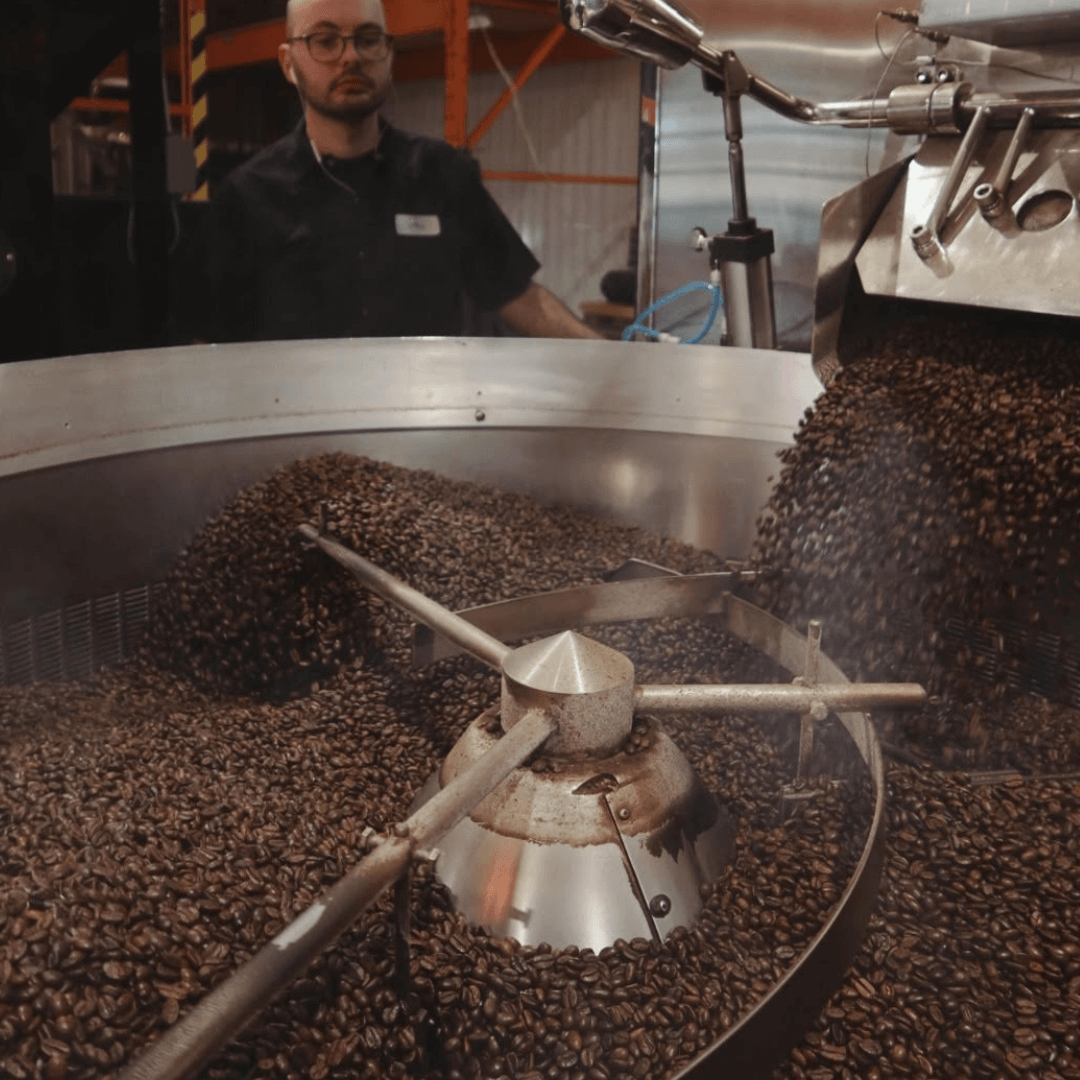Article: The art of roasting: our secrets after 30 years in the business

The art of roasting: our secrets after 30 years in the business
In the world of coffee, every detail counts. At Café Castelo, nothing is left to chance, from roasting to sorting to quality testing. Our approach is based on a simple conviction: for a coffee to be exceptional, you have to understand the science behind each bean, and respect it down to the last drop.
Welcome behind the scenes of our workshop, where traditional craftsmanship and cutting-edge technology work hand in hand.

Infrared roasting: controlling the heat
Roasting is the crucial stage when green coffee is transformed, developing its aromas and color. At Café Castelo, we use infrared micro-roasting technology. Infrared heats the beans by radiation rather than by contact with hot air or flame. This method heats the bean from the inside out, avoiding surface scorching while ensuring even cooking at the core.
Result:
- perfectly developed seeds
- without smoky or bitter notes
- better conservation of the sugars and essential oils responsible for the body and crema
- and impeccable consistency from batch to batch.
This precision is the key to revealing the aromatic complexity of each origin and exclusive blend: high-altitude coffees, rich in organic acids, gain in sweetness and brightness; full-bodied coffees develop a deep, chocolaty roundness without bitterness.
Infrared is modernity at the service of craftsmanship: gentler, more respectful and more consistent roasting.
Slow roasting: respecting the natural rhythm of the bean
In addition to infrared technology, we also prefer slow roasting.
Each firing is carried out slowly at a lower temperature, giving the grain time to fully develop its aromatic profile without heat stress.
This gentle approach offers several major advantages:
- gradual caramelization of natural sugars, bringing roundness and length to the palate
- better internal grain homogeneity, without scorching or overheating
- better digestibility, as acid and volatile compounds are naturally stabilized
- and a more balanced cup, where primary, secondary and tertiary aromas coexist harmoniously.
Slow roasting is an artisanal choice: taking the time needed to let the beans reveal all their richness, rather than pushing them to performance.

Filtration: purity first and foremost
Before, during and after roasting, each coffee bean undergoes several filtration stages designed to guarantee the cleanliness, consistency and safety of the final product.
Two filtrations of coffee dust (before roasting)
Before entering the roaster, the beans first undergo two separate filtrations designed to remove any traces of coffee dust accumulated during transport and drying. This fine, often invisible dust can alter the regularity of the roasting process by preventing the heat from circulating evenly. By removing it completely, we obtain a homogeneous thermal profile, and therefore a stable, precise roast, with no areas of over- or under-roasting.
Foreign body filtration (after roasting)
Once roasting is complete, the beans undergo mechanical filtration to remove foreign bodies. This stage eliminates any hard or abnormal elements, such as twigs, stem fragments or volcanic rocks, which are sometimes present in high-altitude coffees. This is a crucial step in protecting coffee grinders and espresso machines, while guaranteeing pure coffee, free from impurities and risks to our customers' equipment.
The optical eye (final sorting)
Finally, the coffee passes under the optical eye, an ultra-precise sorting technology that analyzes each bean individually. In just a few milliseconds, the machine evaluates the color, shape and density of each bean. Any deviations, such as beans that are too pale, burnt, broken or damaged, are automatically ejected.
Why? Because a cup of coffee contains around 100 beans, and 3 or 4 imperfect beans are enough to upset the balance. These "off-profile" beans add bitterness, unpleasant acidity or herbaceous notes.
Thanks to the optical eye, we can guarantee absolute homogeneity, consistency and aromatic purity. It's a technology that very few artisanal roasters possess, but for us it's essential.
Moisture: the invisible heart of quality
Humidity control is one of the most critical parameters in roasting. Yet it is often the most misunderstood by the general public.
Before roasting: the green bean
Green coffee should contain between 9% and 12% moisture, according to the standards of the Specialty Coffee Association (SCA ) and the International Coffee Organization (ICO).
This is the ideal beach to guarantee :
- stable, uniform roasting
- optimum preservation
- and balanced grain density.
Below 9%, the grain becomes brittle and too dry: it heats too quickly and burns before developing its internal aromas. Above 12%, the grain becomes unstable: it heats slowly, cooks unevenly and risks fermenting.
⚠️ The critical threshold: 12.5
Above 12.5%, green coffee is considered to be non-compliant with international standards.
Why is this? Because it enters a health risk zone. Grain that is too moist encourages the development of molds and mycotoxins, notably ochratoxin A, a substance regulated by Health Canada and the European Union. These micro-fungi develop inside the grain, invisible to the naked eye, but devastating for food quality and safety.
Coffee that is too wet may be downgraded or banned from sale. At Café Castelo, every batch we receive is analyzed: we refuse any raw material that does not comply with this strict standard.
After roasting
Once roasted, coffee naturally loses moisture. The optimum level is between 1% and 3%, depending on the degree of roasting.
This residual moisture is essential for :
- preserve volatile aromas
- prevent drying out and loss of body
- to guarantee better preservation.
Coffee that's too dry becomes dull and brittle; too wet, it deteriorates faster and encourages condensation in the packaging. That's why we systematically measure humidity before and after each roast in our laboratory.
Our laboratory: science at the service of taste
At the heart of our plant, our quality control laboratory plays a crucial role. Here we carry out pre- and post-refining tests, including :
- moisture and density measurement
- checking the rate of mass loss
- assessment of aromatic development
- and visual and olfactory batch analysis.
This technical data enables us to fine-tune our cooking profiles according to each origin, season and harvest batch. Every variable - temperature, time, air flow - is recorded, compared and optimized.
Tasting after each roast: the final judgement
Even with all the technology in the world, there's no substitute for taste. After each roast, our team carries out a sensory tasting (cupping). We taste each roasted batch to assess :
- aromatic balance
- softness, texture
- and consistency with the expected profile.
If the slightest deviation is detected, we adjust and discard. It's this daily rigor that makes Café Castelo's reputation: a coffee that's at once artisanal, consistent and remarkably pure.
A unique test room: coffee tested on all machines
We know that exceptional coffee has to be good, whatever the machine. That's why our test room at the Saint-Nicolas plant contains all the leading coffee makers on the market: espresso, automatic, filter, Keurig, Nespresso, Italian, French and more. Each batch is prepared on several types of equipment to ensure that the taste remains consistent and balanced, whether you're a fan of filter coffee or strong espresso. This approach allows us to adjust our grinding and roasting profiles so that each coffee performs at its best in every context.
Café Castelo: the science of coffee, the soul of the family
Our know-how is a blend of experience, passion and precision. Every step, from green bean to cup, is measured, tested, tasted and validated. We believe that quality can't be claimed, it has to be demonstrated, bean by bean.
At Café Castelo, infrared roasting, optical eye, laboratory, sensory testing and multiple filtrations are not extras. They are the foundations of our commitment: to offer an authentic, consistent and irreproachable coffee, worthy of the trust our customers place in us.


Leave a comment
This site is protected by hCaptcha, and hCaptcha's Privacy Policy and Terms of Service apply.